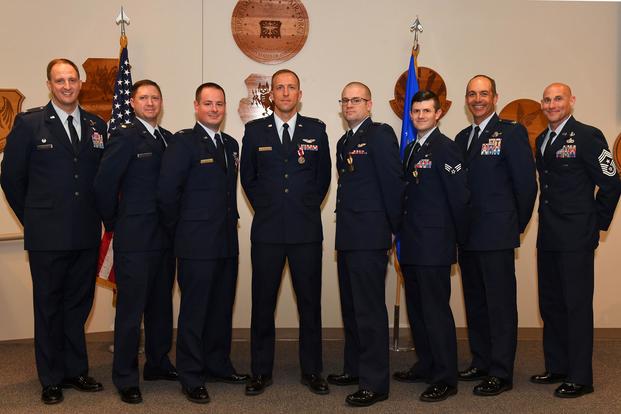The Air Force awarded its first five "R" devices this week, recognizing the outstanding performance of drone operators contributing to combat missions remotely.
The device was presented to four MQ-9 Reaper pilots and one sensor operator from the 432nd Wing at Creech Air Force Base, Nevada, all identified only by rank and first name for security reasons.
The pilots included Maj. Asa, Capt. Evan, Capt. Abrham and 1st Lt. Eric; and the sensor operator was Senior Airman Jason, according to an Air Force news release published Thursday.
The awards were presented for three separate operations against the Islamic State in Iraq and Syria, one of which took place in February 2016, one in August 2016, and the third was not specified, according to the release and award citations obtained by Military.com.
The February operation, involving pilots Asa and Evan, involved a 74-day persistent attack and reconnaissance campaign focused on one ISIS militant described in the release as a "high-value target and known terrorist" and the number-two enemy in the region.
They user Reapers to coordinate with other aircraft on the battlefield and "buddy-lased" to guide and execute the strike, taking out the high-value militant.
The August operation, described in medal citations, involved pilot Eric and sensor operator Jason.
Eric, then piloting an MQ-1B Predator, discovered a pickup truck loaded with a large-caliber machine gun, headed toward friendly forces on the ground. While the pilot watched, the truck would fire at the friendly troops, then pull back and hide in a garage.
According to citations, Eric and Jason contacted their controller, asking for a nine-line order to take out the target.
"While maneuvering to meet a restricted run-in heading, [Eric] observed a large group of civilians, including children, on the opposite side of the road in an alley near where the technical was firing," his citation reads. "[Eric] elected to wait until the technical returned to the garage to minimize collateral damage despite increasing the complexity of the attack."
When the truck came back, Eric and Jason obliterated it with an AGM-114 Hellfire missile, killing two enemy fighters in the process, according to the citation.
The third operation, for which the Air Force did not release a timeframe, involved pilot Abrham.
He and his aircrew had been scanning a hostile area when weather turned bad, forcing manned aircraft in the region to retreat to safety, according to a release. The team stayed on station with their Reaper and, several hours later, they saw enemy fighters start to fire on friendly forces.
"While battling increasingly adverse conditions, Abrham dynamically employed four Hellfire missiles, eliminating three enemy targets, two vehicles, and one mortar system," an Air Force release states. "He then navigated the safe return of his aircraft despite the marginal weather."
The commander of the 432nd, Col. Julian Cheater, applauded the five airmen, who received Meritorious Service Medals and Air Force Commendation Medals affixed with the "R" Device.
"It is a great honor to recognize the contributions of these Airmen," Cheater said in a statement. "Much of the world will never know details of their contributions due to operational security, but rest assured that they have made significant impacts while saving friendly lives."
The "R" device was authorized with clear specifications for each service last year, and can be awarded for operations dating back to January 2016. It's a move on the part of the Defense Department to recognize the work of those who go above and beyond in support of military operations, sometimes from thousands of miles away from the battlefield.
The Air Force is not the first service to award the new device; last December, the Marine Corps presented Navy and Marine Corps Achievement Medals bearing the device to two staff sergeants who operated unmanned aerial systems in support of an unspecified military operation.
-- Hope Hodge Seck can be reached at hope.seck@military.com. Follow her on Twitter at @HopeSeck.












